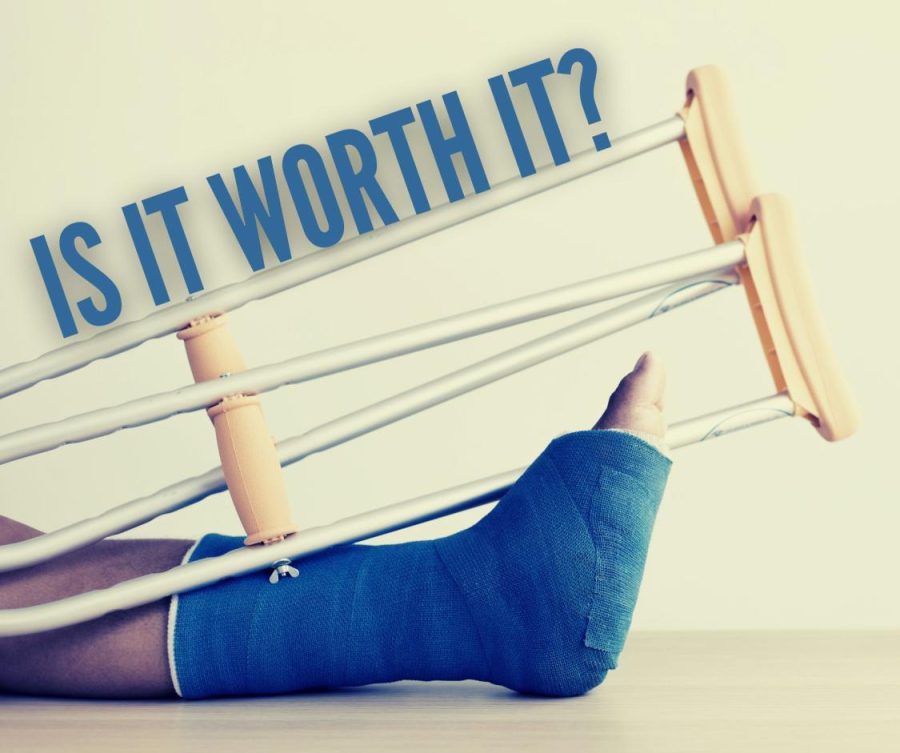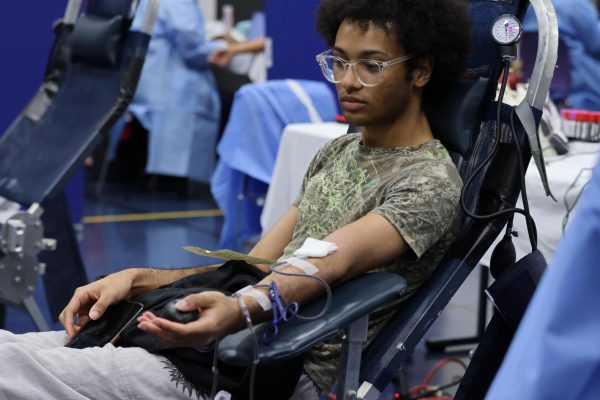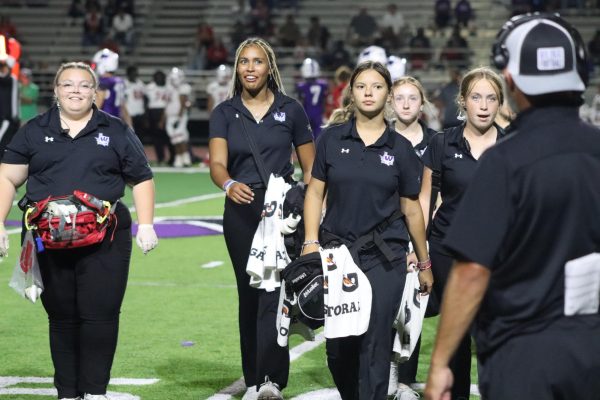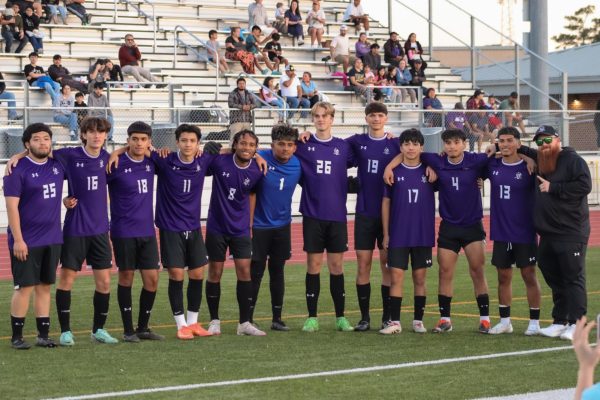Effects of sports injuries live long past glory days
Is it worth it?
photo or infographic by Jason Clark
IS IT WORTH IT? Playing sports often leads to injuries.
It’s Friday night and the first game of her high school career. For years she has dreamed of playing high school basketball and tonight is her chance to enter the team with a bang. The stands are full. The crowd is loud. It is her time to shine.
Then she finds herself at the wrong place at the wrong time. She is shoved off her feet. Unfortunate circumstances and pure chance intervene. Time seems to grind to a halt as the athlete careens towards the floor of the court. Though she is aware of what’s about to happen, she is powerless to prevent it. As an outstretched hand makes contact with the ground, there is a sickening snap and flash of white hot pain.
The season is over before it begins.
As sports such as softball and track kick off their seasons, the balance of the risk of injury and the reward of participation are once again being brought back into the public eye. There is not a day when there is not an athlete on crutches, in a boot or wheeling one of those scooters down the hall.
When playing sports and especially those involving contact, injuries are inevitable. Given enough time, an athlete will be injured at some point or another. How bad these injuries become and how long they last is often dependent on how early and effectively they are treated.
“We see a lot of cases where kids are saying this has been going on for weeks at a time,” licensed and certified athletic trainer Jordan Terrell said. “Then we’re kind of having to play catch up with them. The quicker that we catch the injury, the less long term effects we’re gonna have such as losing the range of motion and strength. The quicker we get on top of it and start with the range of motion piece and the strength piece, then we don’t have to worry about the long term effects.”
There are some injuries, however, that leave lingering effects no matter how well they are treated. It would almost be impossible to find a former athlete that doesn’t have a left over injury, whether that be a bum knee or a clicky wrist.
“When I was a freshman in high school, I was in a collision at home plate when I played catcher for the baseball team,” teacher Chris Slovak said. “Now, I feel like my knees are about 80 years old. They tell me when the weather’s going to change.”
For many of those with lingering issues caused by sports, the experience of playing the sport was more than worth the pain and loss of mobility they deal with every day.
“I wouldn’t change anything,” Slovak said. “I love playing baseball. The only thing I regret is not getting to play it more. I’m not destined to live the rest of my life out in a wheelchair, on my couch or anything like that. But to play super competitively I was no longer able to do that, especially as a catcher.”
Injuries can change the course of someone’s life. Scholarships and other opportunities are often dependent on the student athlete being capable of playing for the team in college. Injuries can put those opportunities in jeopardy.

“The spring of my freshman year I walked into the football facility and told the secretary I’d like to know when walk-on tryouts were,” Willis graduate and former University of Texas football player Josh Matthews said. “She didn’t know, but it just so happened that Bob Shipley (the walk-on coordinator) was coming down the hall. I shook his hand, tried out February 14th and got an email saying I made it a few weeks later. I tore the good ole’ ACL on the first day of spring football practice.”
Even when these opportunities are taken away by injuries, many athletes still find that the being on the team, regardless of how long their stay was, was worth everything they may have lost.
“Injuries happen, but what you learn from sports is worth every second of recovery,” Matthews said. “The best way to avoid an injury is to play full speed and stay hydrated, but remember that at the end of the day you can only control what you can control. In my eyes, the danger of injury isn’t just worth playtime, it’s worth practice time, team bonding time, workouts and all the little things that go into being an elite athlete.”
On the other hand, there are many who’ve found that for them, the injury far outweighs the benefits they may have gained. This can be due to the drop in mobility or the constant pain that some injuries cause and continue to cause throughout their life.
“My neck was really a really bad one,” senior Reid Henderson said. “I still have ailments from that. It’s kind of a nerve shooting through my arm, and even whenever I’m driving it since it was on my left side, whenever I check my blind spot, it’s really hard to twist my neck without support.”
The majority of high school athletes will not compete on the varsity level in college. According to statistics released by the NCAA, the average percentage of high school athletes who compete on a collegiate level is only 7.1%, making the chances of receiving scholarships and other college benefits low.
“I suffered a really bad concussion on Labor Day,” Henderson said. “And that’s kind of what drove me to be like, yeah, I am not doing this anymore because it really wasn’t worth it. I mean, I’m an academic guy. I’m not going to play on the collegiate level. I didn’t want to, and I wasn’t going to get anything out of it.”
From a parental perspective, these injuries can seem like an existential threat to their children. One doesn’t have to look far to find tragic stories of kids dying on the field and the thought of their son or daughter going to play a game and never coming back is too much for some parents.
“As parents constantly we worry about our children, and when they play a sport such as football we worry even more,” Christina Henderson, English teacher and parent of Reid Henderson, said. “It’s a worry that isn’t necessary. It’s an extracurricular. I think something that stuck with me for so many years is when I was in middle school, there was a huge game between Conroe High School and Bryan. Three kids were paralyzed in that game for life, just from that football game and that stuck with me. It’s stuck with me for 35 years.”
Athletes who get injured can sometimes develop mental blocks towards the sport they are participating in. This is often because of the pain they now associate with the sport.
“You just want to get back into it as fast as possible but you can’t,” junior Dario Lozano said. “It’s tough to rehab, it is, but the problem is getting the confidence to go back into the sport. In your head mentally you don’t want to do this again because it affects you drastically. After you tear or break something you don’t want to do it again because after all the processes you’ve been through.”
Though any number of statistics and personal stories can be shown to support one side or the other, in the end, it is the athletes themselves who choose if they play or if they don’t. No one can make that choice for them.
“When I was in football, I loved lifting and stuff. Working out everyday felt nice. I loved playing football,” Lozano said. “But after the injury, it’s kind of iffy. It depends on the love for the sport. If you really love it you go back, but if the love of the sport died down, you shouldn’t.”
Your donation will support the student journalists of Willis High School. Your contribution will allow us to purchase equipment and cover our annual website hosting costs.

Jason Clark is a senior at Willis High School and is currently enrolled in newspaper and yearbook. Jason is a four-year journalism student and has placed...












